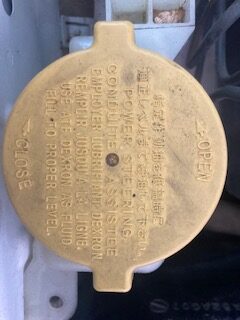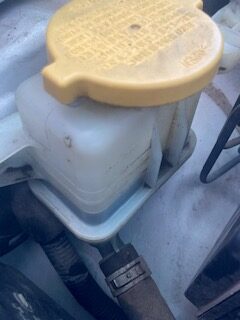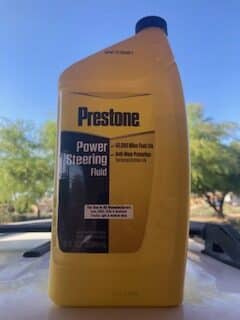

The power steering system is an integral part of modern vehicles, enhancing driving comfort and control. At the heart of this system lies the power steering fluid, a hydraulic liquid that transmits the force from the steering wheel to the wheels. However, sometimes this crucial component of your vehicle can experience a leak, which can lead to severe problems if left unchecked.
Understanding Power Steering Fluid Leak

A power steering fluid leak is a common issue that can befall any vehicle. It happens when the fluid escapes from the sealed power steering system, often due to damage or wear and tear. This fluid is crucial for the proper functioning of your power steering system, as it helps to transmit pressure and lubricate the system, reducing friction and wear on your vehicle’s components.
Causes of Power Steering Fluid Leaks
The causes of power steering fluid leaks are varied. They can range from normal wear and tear over time, a damaged power steering pump, cracked or loose hoses, a faulty power steering rack, or bad seals. In older vehicles, the natural degradation of parts can lead to leaks, while in newer cars, poor maintenance or accidental damage may be the culprit.
Symptoms of Power Steering Fluid Leaks
Symptoms of a power steering fluid leak can be subtle at first but can quickly escalate if not addressed. Some common signs include difficulty in steering, particularly at slow speeds or while parking. You may also notice a squealing or whining noise when turning the wheel, stains under the car where it has been parked, or a lower than usual fluid level in the power steering reservoir.
How to Identify a Power Steering Fluid Leak
Identifying a power steering fluid leak often involves a visual inspection of your vehicle’s power steering system for any signs of leakage, such as fluid on parts or under the car. Checking the fluid levels regularly can also help identify if you’re losing fluid faster than normal. However, if you suspect a leak, the best course of action is to seek a professional diagnosis to avoid damaging your power steering system further.
Solutions for Power Steering Fluid Leak

Depending on the cause and severity of the leak, solutions can range from simply replacing damaged components or topping up and flushing the system to a complete power steering system overhaul. It’s crucial to use the correct type of power steering fluid for your vehicle when topping up or replacing the fluid to avoid causing further damage.
The Cost of Power Steering Leak Repair: A Comprehensive Breakdown

Fixing a power steering leak can vary widely in cost, depending on the severity of the leak and the specific parts that need repair or replacement. Below, we provide a rough estimate of the costs associated with fixing a power steering leak:
Minor Repairs (e.g., hose replacement or minor seal leaks): $100 – $300
If the leak is minor and confined to easily accessible parts like the hoses or seals, the repair costs can be quite reasonable. This range includes both parts and labor.
Moderate Repairs (e.g., pump replacement): $200 – $500
If the power steering pump is faulty and needs to be replaced, the cost can increase. This range also includes both parts and labor.
Major Repairs (e.g., steering rack or pinion replacement): $500 – $1500
For more serious leaks, such as those involving the steering rack or pinion, the cost will be significantly higher due to the expense of the parts and the labor-intensive nature of the repair.
Remember, these are rough estimates, and actual costs can vary based on factors such as the make and model of your vehicle, the hourly labor rate of the mechanic, and the region in which you live. Always obtain a detailed estimate from your mechanic before proceeding with any repair work.
Preventive Measures Against Power Steering Fluid Leak
Prevention is better than cure, and that’s particularly true for power steering fluid leaks. Regular maintenance of your vehicle can help prevent these issues from arising. This includes regular checks and replacement of the power steering fluid as recommended by your vehicle manufacturer, using quality replacement parts, and professional check-ups, particularly if you notice any of the symptoms mentioned above.
A power steering fluid leak is a serious issue that should not be overlooked. It’s crucial to understand the causes, symptoms, and solutions associated with it to prevent damage to your vehicle’s power steering system. Remember, regular maintenance and prompt attention to potential problems can save you from costly repairs down the line.

Proper and regular maintenance of your vehicle’s power steering system is key to its longevity and performance. Here are some guidelines and tips:
Frequency of Power Steering Fluid Checks
Generally, it’s recommended to check your power steering fluid at least once a month. This can help you catch any potential leaks or low fluid levels early, preventing further damage to your vehicle’s steering system.
How to Check Power Steering Fluid
When checking the fluid, ensure that the engine is off and cool. Locate the power steering fluid reservoir (usually marked), remove the cap, and check the fluid level against the minimum and maximum indicators. The fluid should be clear; if it appears cloudy or has a burnt smell, it may need replacing.
Changing Power Steering Fluid
Power steering fluid doesn’t typically require as frequent changes as engine oil. As a rule of thumb, consider changing it every 75,000 miles or every 5 years, whichever comes first. However, always refer to your vehicle’s owner manual for specific guidelines.
Regular System Inspection
Regularly inspect the power steering system for leaks, cracks, or wear in the hoses and belts. Also, pay attention to any changes in steering feel or noises while turning, as these could indicate an issue.
Professional Servicing
Even with regular self-checks, it’s a good idea to have a professional mechanic inspect the power steering system at least once a year, or during routine maintenance appointments.
Use Recommended Fluid
Always use the type of power steering fluid recommended in your vehicle’s owner manual. Using the wrong fluid can lead to increased wear and potential damage.
Risks of Not Using the Recommended Power Steering Fluid
Using the wrong power steering fluid for your vehicle can lead to several potential problems, some of which can be quite severe. Here are a few of the risks associated with not using the recommended power steering fluid:
Damage to the Power Steering System
Power steering fluids are specifically formulated for different types of steering systems. Using the wrong fluid can result in improper lubrication, leading to increased friction and accelerated wear and tear on the system’s components.
Reduced Performance
The incorrect fluid may not provide the necessary hydraulic pressure needed for your specific power steering system, leading to reduced steering performance. This can make the steering feel heavier or less responsive, impacting overall driving experience.
Seal and Hose Deterioration
Certain types of power steering fluid may contain additives or chemicals that are incompatible with the seals and hoses in your power steering system. This can lead to premature deterioration, causing leaks and system failure over time.
Voided Warranty
Using a non-recommended power steering fluid might void your vehicle’s warranty. This means any damage resulting from the use of the wrong fluid will not be covered, potentially leading to significant out-of-pocket expenses.
Complete System Failure
In extreme cases, using the wrong power steering fluid can result in complete system failure, necessitating costly repairs or replacements.
In short, it’s crucial to always use the power steering fluid specified in your vehicle’s owner manual. This ensures that your power steering system operates as intended, maintains performance, and reduces the risk of expensive repairs.
FAQs: Power Steering Fluid Leak

What Are the Symptoms of a Power Steering Fluid Leak?
Symptoms of a power steering fluid leak may include difficulty steering, a whining noise from the pump, or visible fluid on the ground under the vehicle.
What Causes a Power Steering Leak?
Power steering leaks can be caused by a variety of issues, including worn-out seals, damaged hoses, or a corroded power steering pump.
What Are the Symptoms of Low Power Steering Fluid?
Symptoms of low power steering fluid can include difficulty turning the steering wheel, a squealing noise when you turn the steering wheel, or a jerky or erratic steering motion.
How Much Does It Cost to Repair a Power Steering Fluid Leak?
Repair costs for a power steering fluid leak can vary greatly depending on the source of the leak and the make and model of your vehicle. Generally, it can range from $100 to $1500. For an accurate estimate, it’s best to consult with a professional mechanic.
How Can I Diagnose a Power Steering Leak Myself?
If you suspect a power steering leak, you can check the level of power steering fluid in your vehicle. If the fluid level is low, it could indicate a leak. You may also notice a clear, red or brown fluid on the ground under the vehicle. If the leak is substantial, you should see a mechanic as soon as possible.
What Can Happen If I Ignore a Power Steering Leak?
Ignoring a power steering leak can lead to more serious issues. If the fluid level gets too low, the power steering pump may become damaged, making the steering very difficult and potentially leading to a loss of control of the vehicle. It’s important to address the issue as soon as possible to avoid more costly repairs down the line.
Can I Drive My Car If It Has a Power Steering Fluid Leak?
While you might still be able to drive your car with a power steering fluid leak, it’s not recommended. The steering may become increasingly difficult, posing a safety risk. Also, continuing to drive your car could cause more damage to the power steering system, leading to a more expensive repair in the future.
How Do I Check My Power Steering Fluid Level?
To check the power steering fluid level, locate the power steering reservoir under the hood of your vehicle. The reservoir typically has a dipstick or a “full/low” line marking. Make sure the engine is cold when you check the level. If the fluid level is below the “low” marking or if the reservoir is empty, you might have a leak.
Can I Use Any Power Steering Fluid in My Car?
It’s important to use the type of power steering fluid that is recommended by your vehicle’s manufacturer. Using the wrong type of fluid could cause damage to your power steering system. You can find the correct type of fluid to use in your vehicle’s owner’s manual.
Can Power Steering Fluid Leak Cause Overheating?
Generally, a power steering fluid leak itself won’t cause the car to overheat. However, if the leaking fluid comes into contact with parts of the engine or exhaust system, it could potentially cause overheating or even a fire. If you suspect a leak, it’s crucial to get it checked out immediately.
How Often Should I Change My Power Steering Fluid?
The frequency for changing power steering fluid can vary depending on your vehicle’s make and model. As a general rule of thumb, many experts recommend changing power steering fluid every 50,000 to 100,000 miles, or every 2 to 3 years. Always check your vehicle’s owner’s manual for specific recommendations.


